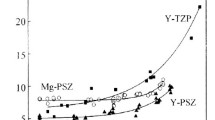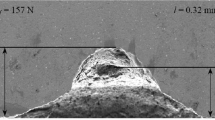The fracture of zirconia ceramics both at macro (specimen bending with a stress raiser in the tensile region) and micro (Rockwell indentation with specimen edge chipping) levels was studied. Experimental data, plotted on the classification diagram of brittle materials at their micro and macrofracture (FR - KIc relation), did not fall on the baseline constructed by chipping results of simple single-phase ceramics, demonstrating a significant difference in the properties of zirconia ceramics (Y-TZP, Mg-PSZ, and composite ZrO2/Al2O3 as compared to those of single-phase materials, which must not be overlooked in such an important application as dentistry. Therefore, the behavior of those ceramics on microfracture was studied with the Edge Chipping EF method. It involves the chipping of a polished rectangular prismatic specimen with an indenter impressed near its sharp edge. The edge chipping of tested specimens was effected with a Rockwell indenter as the basic instrument, and the additional ones were a standard Vickers indenter and a diamond cone with a tip radius of 400 μm. Analysis of the test results also included fracture toughness data on examined ceramics obtained with the SEVNB method, which involves bending of a prismatic specimen with a transverse through sharp V-notch in the tensile region.








Similar content being viewed by others
References
J. Chevalier, “What future for zirconia as a biomaterial?,” Biomaterials, 27, No. 4, 535–543 (2006).
R. C. Garvie, R. H. J. Hannink, and R. T. Pascoe, “Ceramic steel?,” Nature, 258, 703–704 (1975).
G. A. Gogotsi, “Fracture behaviour of Mg-PSZ ceramics: Comparative estimations,” Ceram. Int., 35, 2735–2740 (2009).
ISO 23146, Fine Ceramics (Advanced Ceramics, Advanced Technical Ceramics) – Test Methods for Fracture Toughness of Monolithic Ceramics – Single-Edge V-Notch Beam (SEVNB) Method, Switzerland (2008).
G. A. Gogotsi, V. Y. Galenko, and G. de Souza, “Dental Y-TZP ceramics: local fracture resistance,” Strength Mater., 53, No. 3, 471–476 (2021). https://doi.org/10.1007/s11223-021-00308-9
G. A. Gogotsi, “The use of brittleness measure (χ) to represent mechanical behavior of ceramics,” Ceram. Int., 15, 127–129 (1989).
S. P. Timoshenko and J. N. Goodier, Theory of Elasticity, McGraw-Hill, New York (1970).
G. R. Anstis, P. Chantikul, B. R. Lawn, and D. B. Marshall, “A critical evaluation of indentation techniques for measuring fracture toughness: direct crack measurements,” J. Am. Ceram. Soc., 64, 533–538 (1981).
G. D. Quinn and R. C. Bradt, “On the Vickers indentation fracture toughness test,” J. Am. Ceram. Soc., 90, 673–680 (2007).
N. B. Thomsen, D. M. Stump, and L. M. Keer, “Surface uplift and implications of zirconia toughened ceramics,” Int. J. Mech. Sci., 38, 233–245 (1996).
A. Bravo-Leon, Y. Morikava, M. Kawahara, and M. J. Moyo, “Fracture toughness of nanocrystalline tetragonal zirconia with low yttria content,” Acta Mater., 50, No. 18, 4555–4562 (2002).
G. D. Quinn, J. J. Kubler, and R. J. Gettings, Fracture Toughness of Advanced Ceramics by the Surface Crack in Fracture (SCF) Method: a VAMAS Round Robin, VAMAS Report, No. 17, USA (1994).
E. A. Almond and N. J. McCormick, “Constant-geometry edge flaking of brittle materials,” Nature, 321, 53–55 (1986).
G. A. Gogotsi and S. P. Mudrik, “Fracture barrier estimation by the edge fracture test method,” Ceram. Int., 35, 1871–1875 (2009).
G. A. Gogotsi, V. I. Galenko, S. P. Mudrik, et al., “Fracture resistance estimation of elastic ceramics in edge flaking: EF baseline,” J. Eur. Ceram. Soc., 30, No. 6, 1223–1228 (2010).
J. J. Kruzic, D. K. Kim, K. J. Koester, and R. O. Ritchie, “Indentation techniques for evaluating the fracture toughness of biomaterials and hard tissues,” J. Mech. Behav. Biomed. Mater., 2, No. 4, 384–395 (2008).
Author information
Authors and Affiliations
Corresponding author
Additional information
Translated from Problemy Mitsnosti, No. 5, pp. 96 – 107, September – October, 2022.
Rights and permissions
Springer Nature or its licensor (e.g. a society or other partner) holds exclusive rights to this article under a publishing agreement with the author(s) or other rightsholder(s); author self-archiving of the accepted manuscript version of this article is solely governed by the terms of such publishing agreement and applicable law.
About this article
Cite this article
Gogotsi, G.A. Comparative Estimation of Fracture Resistance Test Methods: Zirconia Ceramics. Strength Mater 54, 841–849 (2022). https://doi.org/10.1007/s11223-022-00460-w
Received:
Published:
Issue Date:
DOI: https://doi.org/10.1007/s11223-022-00460-w




